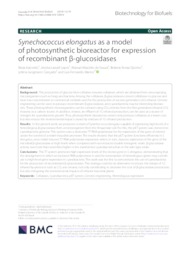Synechococcus elongatus as a model of photosynthetic bioreactor for expression of recombinant B-glucosidases.
Synechococcus elongatus as a model of photosynthetic bioreactor for expression of recombinant B-glucosidases.
Author(s): AZEVEDO, R.; LOPES, J. L.; SOUZA, M. M. de; QUIRINO, B. F.; JUNGMANN, L.; MARINS, L. F.
Summary: Background: The production of glucose from cellulose requires cellulases, which are obtained from decomposing microorganisms such as fungi and bacteria. Among the cellulases, β-glucosidases convert cellobiose to glucose and have low concentration in commercial cocktails used for the production of second-generation (2G) ethanol. Genetic engineering can be used to produce recombinant β-glucosidases, and cyanobacteria may be interesting bioreactors. These photosynthetic microorganisms can be cultured using CO2 emitted from the first-generation ethanol (1G) industry as a carbon source. In addition, vinasse, an effluent of 1G ethanol production, can be used as a source of nitrogen for cyanobacteria growth. Thus, photosynthetic bioreactors cannot only produce cellulases at a lower cost, but also reduce the environmental impact caused by residues of 1G ethanol production. Results: In the present work, we produced a strain of Synechococcus elongatus capable of expressing high levels of a heterologous β-glucosidase from a microorganism from the Amazonian soil. For this, the pET system was cloned into cyanobacteria genome. This system uses a dedicated T7 RNA polymerase for the expression of the gene of interest under the control of a nickel-inducible promoter. The results showed that the pET system functions efficiently in S. elongatus, once nickel induced T7 RNA polymerase expression which, in turn, induced expression of the gene of the microbial β-glucosidase at high levels when compared with non-induced double transgenic strain. β-glucosidase activity was more than sevenfold higher in the transformed cyanobacteria than in the wild-type strain. Conclusions: The T7 system promotes high expression levels of the cloned gene in S. elongatus, demonstrating that the arrangement in which an exclusive RNA polymerase is used for transcription of heterologous genes may contribute to high-level gene expression in cyanobacteria. This work was the first to demonstrate the use of cyanobacteria for the production of recombinant β-glucosidases. This strategy could be an alternative to reduce the release of 1G ethanol by-products such as CO2 and vinasse, not only contributing to decrease the cost of β-glucosidase production, but also mitigating the environmental impacts of ethanol industrial plants.
Publication year: 2019
Types of publication: Journal article
Unit: Embrapa Agroenergy
Keywords: Cellulases, Cyanobacteria, Genetic engineering, PET system
Observation
Some of Embrapa's publications are published as ePub files. To read them, use or download one of the following free software options to your computer or mobile device. Android: Google Play Books; IOS: iBooks; Windows and Linux: Calibre.
Access other publications
Access the Agricultural Research Database (BDPA) to consult Embrapa's full library collection and records.
Visit Embrapa Bookstore to purchase books and other publications sold by Embrapa.

